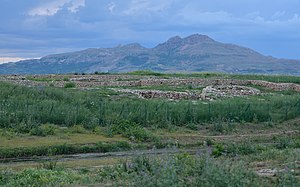


The site of Çayönü, in southeastern Turkey
| |
|
Show map of Near East
Çayönü (Turkey) Show map of Turkey | |
| Location | Diyarbakır Province, Turkey |
|---|---|
| Coordinates | 38°12′59″N 39°43′35″E / 38.21639°N 39.72639°E / 38.21639; 39.72639 |
| Type | Settlement |
| History | |
| Founded | 8,630 BC[1] |
| Abandoned | 6,800 BC[1] |
| Periods | Neolithic |
Çayönü Tepesi is a Neolithic settlement in southeastern Turkey which prospered from circa 8,630 to 6,800 BC.[1] It is located in Diyarbakır Province forty kilometres north-west of Diyarbakır, at the foot of the Taurus mountains. It lies near the Boğazçay, a tributary of the upper Tigris River and the Bestakot, an intermittent stream. It is an early example of agriculture.
At first, Cayonu represented single room structures that were round or had rounded corners. On top were built wattle and daub constructions. The next phase consisted of grill-plan buildings. This refers to a type of the building foundation.



The site was excavated for 16 seasons between 1964 and 1991, initially by Robert John Braidwood and Halet Çambel and later by Mehmet Özdoğan and Aslı Erim Özdoğan.[3][4] The settlement covers the periods of the Pre-Pottery Neolithic A (PPNA), the Pre-Pottery Neolithic B (PPNB), and the Pottery Neolithic (PN).
The stratigraphy is divided into the following subphases according to the dominant architecture:[5]
An analysis of blood found at the site suggested that human sacrifice occurred there.[6]
The settlement attests to the period of transition from hunting and gathering to plant and animal domestication. Domestic animals appear in the final aspects of Phase I (preceramic); prior to that, the bones of wild game are relatively abundant. Mainly sheep was domesticated at first.[7]
In regard to cattle domestication, recently (2021) scholars make a distinction between “cattle management” and “domestic cattle”. Çayönü Tepesi provides a time sequence clarifying changes in the human management of Bos populations from the earliest times.[8]
Arbuckle and Kassebaum outline several stages of cattle management at Cayonu, and they present a rather complicated picture. Bos remains are abundant already in the earliest levels representing c. 20% of the mammalian remains. Much later, around 7500 BC, cattle reach their maximum abundance at the site, but they are still phenotypically unchanged. Decrease in cattle size is evident only around 7000 BC, and continues thereafter at this and related sites in the area.[8]
Çayönü is possibly the place where the pig (Sus scrofa) was first domesticated.[9]
Genetic studies of emmer wheat, the precursor of most current wheat species, show that the slopes of Mount Karaca (Karaca Dağ), which is located in close vicinity to Çayönü, was the location of first domestication. A different DNA approach pointed to Kartal Daği.[10]
Robert Braidwood wrote that "insofar as unit HA can be considered as representing all of the major pre-historic occupation at Cayonu, cultivated emmer along with cultivated einkorn was present from the earliest sub-phase."[11]
{{cite book}}: CS1 maint: location missing publisher (link)
|
| |
|---|---|
| Aegean |
|
| Black Sea |
|
| Central Anatolia |
|
| Eastern Anatolia |
|
| Marmara |
|
| Mediterranean |
|
| Southeastern Anatolia |
|